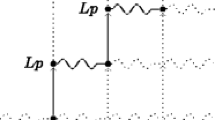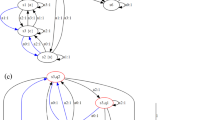Abstract
The complexities of the possible rendezvous and the lockout problems for propositional concurrent programs are investigated in detail. We develop a unified strategy, based on domino tiling, to show that the above two problems with respect to a variety of propositional concurrent programs are complete for a broad spectrum of complexity classes, ranging from NLOGSPACE, PTIME, NP, PSPACE to EXPTIME. Our technique is novel in the sense that it demonstrates how two seemingly unrelated models, namely, propositional concurrent programs and dominoes, can be linked together in a natural and elegant fashion.
Similar content being viewed by others
References
Berger, R. The undecidability of the domino problem.Mem. Amer. Math. Soc., 66, 1966.
Chandra, A., Kozen, D., and Stockmeyer, L. Alternation.J. Assoc. Comput. Mach., 28:114–133, 1981.
Chlebus, B. Domino-tiling games.J. Comput. System Sci., 32:374–392, 1986.
Chlebus, B. Proving NP-completeness using bounded tiling.J. Inform. Process. Cybernet. EIK, 8:479–484, 1987.
Fischer, M., and Ladner, R. Prepositional dynamic logic of regular programs.J. Comput. System Sci., 18:194–211, 1979.
Gradel, E. Domino games and complexity.SIAM J. Comput., 19:787–804, 1990.
Harel, D. Dynamic logic. InHandbook of Philosophical Logic (D. Gabbay and F. Guenthner, eds.), Reidel, Dordrecht, pp. 497–604, 1984.
Harel, D. Recurring dominoes: making the highly undecidable highly understandable.Ann. Discrete Math., 24:51–72, 1985.
Harel, D. Effective transformations on infinite trees, with applications to high undecidability, dominoes, and fairness.J. Assoc. Comput. Mach., 33(l):224–248, 1986.
Hopcroft, J., and Ullman, J.Introduction to Automata Theory, Languages and Computation. Addison-Wesley, Cambridge, MA, 1979.
Kanellakis, P., and Smolka, S. On the analysis of cooperation and antagonism in networks of communicating processes.Algorithmica, 3:421–450, 1988.
Kozen, D., and Tiuryn, J. Logics of programs. InHandbook of Theoretical Computer Science (J. van Leeuwen, ed.), Vol. B, Eisevier, Amsterdam, pp. 789–840, 1990.
Ladner, R. The complexity of problems in systems of communicating sequential processes.J. Comput. System Sci., 21:179–194, 1980.
Lewis, H. Complexity of solvable cases of the decision problem for the predicate calculus.Proc. 19th Ann. IEEE Symp. on Foundations of Computer Science, pp. 35–47, 1978.
Lewis, H., and Papadimitriou, C.Elements of the Theory of Computation. Prentice-Hall, Englewood Cliffs, NJ, 1981.
Peleg, D. Concurrent dynamic logic.J Assoc. Comput. Mach., 34:450–479, 1987.
Peleg, D. Communication in concurrent dynamic logic.J. Comput. SystemSci., 35:23–58, 1987.
Pratt, V. Models of program logics.Proc. 20th Ann. IEEE Symp. on Foundations of Computer Science, pp. 115–122, 1979.
Pratt, V. A near-optimal method for reasoning about actions.J. Comput. System Sci., 20:231–254, 1980.
Savlsberg, M., and van Emde Boas, P. Bounded tiling, an alternative to satisfiability?Proc. 2nd Frege Conference, Schwerin 1984, Mathematische Forschung, pp. 354–363, 1984.
Taylor, R. Complexity of analyzing the synchronization structure of concurrent programs.Acta Inform., 19:57–84, 1983.
Taylor, R. A general-purpose algorithm for analyzing concurrent programs.Comm. ACM, 26(5): 362–376, 1983.
van Emde Boas, P. Dominoes are forever.Proc. 1st GTI Workshop (Paderborn), pp. 76–95, 1983.
Wang, H. Proving theorems by pattern recognition, ii.Bell System Tech. J., 40:1–4, 1961.
Yen, H. A multiparameter analysis of domino tiling with an application to concurrent systems.Theoret. Comput. Sci., 98:263–287, 1992.
Author information
Authors and Affiliations
Rights and permissions
About this article
Cite this article
Yen, H.C., Pak, N. Complexity analysis of propositional concurrent programs using domino tiling. Math. Systems Theory 26, 357–378 (1993). https://doi.org/10.1007/BF01189855
Received:
Revised:
Accepted:
Published:
Issue Date:
DOI: https://doi.org/10.1007/BF01189855




